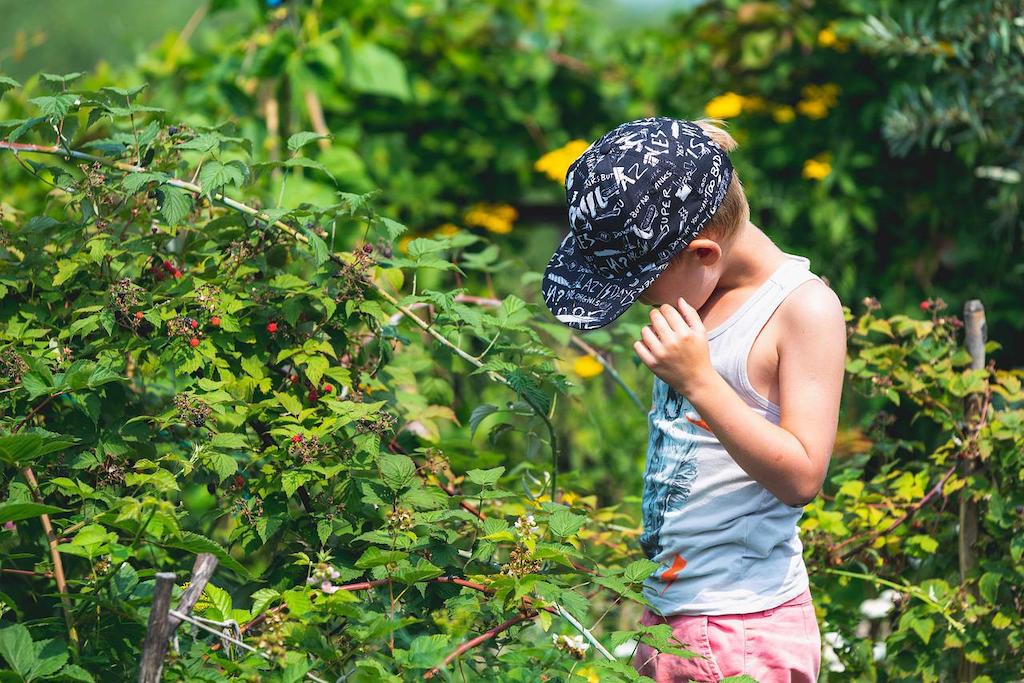
Foraging – connecting with nature through the senses
I became a forager at the age of 5, and I suspect many of you did, too. My early childhood memories are filled with berries of all kinds: wild strawberries, raspberries, blackberries, and above all, blueberries. They covered the forest floor so densely that it was difficult to set down your foot without squashing them.
The summer holidays were pure berry bliss as I munched my way through the landscape like an insatiable caterpillar.
These early sensuous experiences sowed the seeds from which, in time, my passion for nature sprouted.
Nothing can forge a deeper connection to nature and the land than such total immersion – learning by smelling, tasting, eating, feeling and playing with what nature provides in abundance. We learn by doing, observing and asking questions about what we can directly experience. These sensory impressions form the foundations of our understanding of the world.
We learn to understand processes, to see patterns from which we deduce meaning. Such intense observation creates a deep relationship with the observed. We are no longer separated, but deeply and empathically involved. A sense of familiarity and caring develops and gradually grows. A great way to stimulate this learning process is to become a forager.
What is foraging?
The term ‘foraging’ is often associated with animals roaming around looking for food. Different animals forage for different kinds of food. A hedgehog looks for beetles, snails and fallen fruit, while gorillas sustain themselves only on leaves.
As ‘civilized’ human beings, we mostly forage at the supermarket. Everything is always available, and most of us have lost any sense of connection to the cycle of the seasons and the different foods they produce – unless they are gardeners, of course. But before we began domesticating wild species of plants and animals, we incorporated a wide variety of wild species into our diets.
Picking berries or hunting for mushrooms is still hugely popular, especially in times of economic hardship. Some of us continue to forage for part of our diets – not just to save money on the grocery bill, but simply because we love it. We love the connection with the land and the variety of foods and flavours each season provides. Besides, wild foods tend to have a vastly superior nutritional profile compared to industrially farmed produce.
What are wild (plant) foods?
Wild food plants are simply edible plants that are not under cultivation. But the dividing line between wild and cultivated foods can be very vague. Many wild edibles are the undomesticated ancestors of the plants we find at the grocery. Some wild species used to be cultivated and sold on the market but are no longer grown today. Gardeners even curse them as weeds.
Some fruits and nuts are cultivated and found in the wild. The cultivated varieties are bred for specific traits and qualities, such as shelf-life. Their wild cousins tend to be smaller but are often more flavourful.
Whether we can digest any given wild plant is determined by our physiology. Certain plants that would kill us are perfectly edible for other animals.
How to become a forager?
Foraging is a skill that must be learnt like any other.
The best method to learn is to find a knowledgeable mentor or join foraging walks and classes in your neighbourhood.
But there is also much you can learn on your own.
Essential foraging skills:
Learn all you can about your environment
Observe closely, and ask questions:
What kinds of trees, bushes and wildflowers grow here?
Which animals feed on them?
Do certain plants always grow together?
What is the soil like, chalky or loamy, wet or dry?
Do you know what the farmer sprays on his nearby field?
Learn plant identification skills
Foragers must learn basic botany and become familiar with the transformative processes of plants. Learn to recognize them at different stages of their growth cycle. Some species are edible at one stage, but toxic at another.
Learn the seasons
Each season brings forth its special treats, but seasons are not fixed by a calendar. If you know how to read the signs of nature, you will recognize when the time to harvest a specific herb or fruit has come.
Learn how to care for your environment
As foragers, we are stewards of the land, not pillagers. We must not only take but also give back to nature. Remember that you are not the only hungry one out there. Others (human or animal) also depend on the gifts of nature.
Cautions:
Never ever rely on your intuition alone! Even deadly plants and fungi may look, smell or taste deceptively appealing!
Learning everything you can about your environment is the most essential skill a forager must develop.
Always test for allergies before tucking into a foraged feast. The body can be finicky when we ask it to accept foods it has never previously encountered.
And finally – knowing your land also means learning about dangers that may lurk in the undergrowth: snakes, insects (ticks!), wild boars, or even bears, depending on where you live.
Resources:
There are many knowledgeable people out there who teach foraging as a craft – too many to name them all here.
But here are a few useful books. (As an Amazon Associate, I earn from qualifying purchases.)
Keep in mind that each bioregion is unique. There are many differences concerning microclimates, seasons, and habitats. Obviously, I can’t cover them all. I focus on my local bioregion, which is Central Europe.


